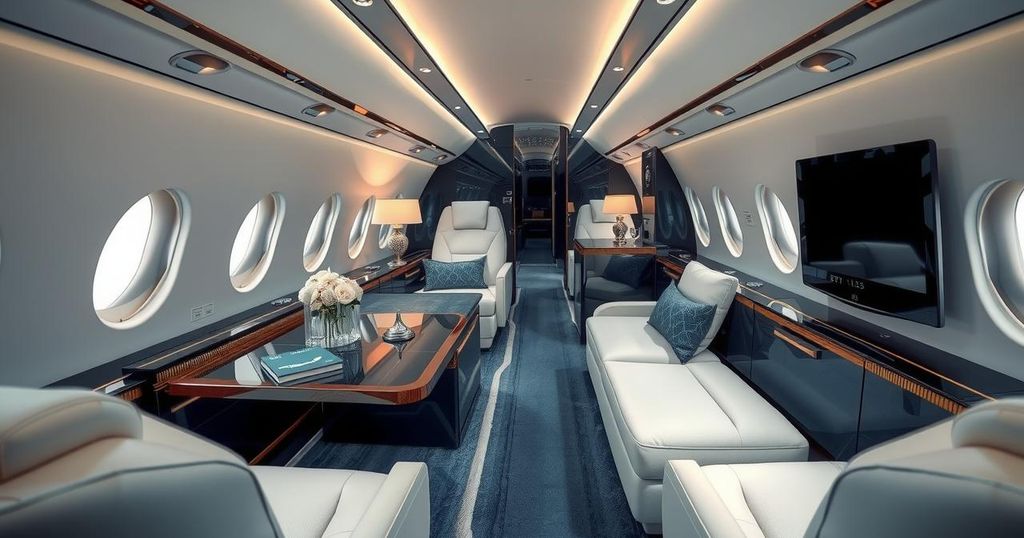Politics
AIR FORCE, AIR FORCE ONE, AP, ASIA, BOEING, DONALD TRUMP, EUROPE, FRANKLIN D. ROOSEVELT, FREEDOM OF INFORMATION, IRAN, MILITARY, NATIONAL SECURITY, NORTH AMERICA, POLITICS, QATAR, TROY MEINK, TRUMP, TRUMP ADMINISTRATION, UKRAINE, UNITED STATES, WASHINGTON, WHITE HOUSE, YALTA
Leila Ramsay
0 Comments
What It Would Take to Convert a Jet from Qatar into Air Force One to Safely Fly Trump
President Trump seeks to use a Qatari jet as an upgraded Air Force One, but adapting the plane poses intricate security challenges and expenses. Air Force Secretary Meink disclosed that modifications would cost below $400 million, although estimates for full retrofitting reach as high as $1.5 billion. Additionally, Trump’s security history raises questions about what allowances he may make regarding safety standards, balanced against the timeline of his presidency.
In a surprising turn of events, President Donald Trump has expressed a keen interest in flying on a new luxurious jet, potentially an upgraded version of Air Force One, that is currently offered by the Qatari royal family. However, the reality of adapting this aircraft to meet national security standards presents significant challenges and costs. As discussions progress about this possible transaction, the safety of the president during transit remains at the forefront.
The modifications needed for the Qatari jet to reach Air Force One standards could run afoul of security protocols currently in place. Air Force Secretary Troy Meink stated that the estimated cost for the required security adjustments is expected to be below $400 million. However, specifics about this budget were not disclosed, and time is ticking as Trump hopes to have this jet operational by the end of his term.
The stakes are high due to President Trump’s history with threats to his safety, including two assassination attempts. While he is aware of these dangers, Trump has displayed a willingness to sidestep some security protocols, particularly concerning communication devices. For instance, he has publicly kept his personal phone accessible, disregarding potential hacking threats, leading to speculation about how far he might go to expedite getting the Qatari plane in service.
Initially used by Franklin D. Roosevelt in 1945, the term “Air Force One” applies to any aircraft transporting the sitting president. Boeing has been busy reconstructing 747s to replace the aging models currently used as Air Force One, with this project reportedly exceeding $5.3 billion and encountering significant delays. Key factors influencing the modifications for the new jets include ensuring aircraft survivability and robust communication capabilities.
Deborah Lee James, former Air Force Secretary, highlighted that the necessity for a four-engine setup ensures that the aircraft can stay airborne even if one or two engines fail. This hinders the availability of easy-to-source parts as modern 747s are no longer being manufactured. Adding to this complexity are the in-depth security features required, such as anti-jamming communication systems and protections against surveillance, enabling the president to maintain command during a crisis.
If retrofitting the Qatari jet adheres to security standards, estimates soar to projected costs of $1.5 billion or more. Concurrently, Meink has countered that some expenses would be incurred regardless of the aircraft upgrade due to standard protocol for the Air Force’s ongoing efforts to establish new presidential planes. Some lawmakers are skeptical of how quickly modifications can realistically be achieved without compromising security.
Meanwhile, Rep. Joe Courtney from Connecticut estimates that basic retrofitting could cost around $1 billion, emphasizing the extensive work needed to bring the Qatari aircraft up to speed. Trump, being the commander in chief, has the power to waive specific requirements and could decide to take certain risks for the sake of quicker delivery. Yet, such decisions should be carefully considered, especially given the public nature of such vulnerabilities.
Public advocates for security emphasize the need for caution, like Senator Tammy Duckworth, who criticized the prospect of flying under-prepared and underscored the importance of ensuring the aircraft can withstand potential nuclear threats. A report from the Government Accountability Office reveals the ongoing issues affecting Boeing’s new Air Force One planes, indicating delays due to technical issues that need resolution before any operational use.
Regardless of how the intricacies of this situation unfold, the paramount aspect is ensuring the safety and security of the president while balancing the significant costs and practical implications of integrating another aircraft into the national framework for presidential travel.
As discussions about adapting a Qatari jet for presidential travel continue, the intersection of security requirements, costs, and Trump’s desires underscores the complexity of the situation. Increasing modifications to the aircraft could lead to exorbitant expenses but potentially sacrificing essential security features is a major concern. With the clock ticking, it remains to be seen how Trump will navigate these challenges while maintaining both safety and his vision of an upgraded Air Force One.
Original Source: www.thespec.com




Post Comment